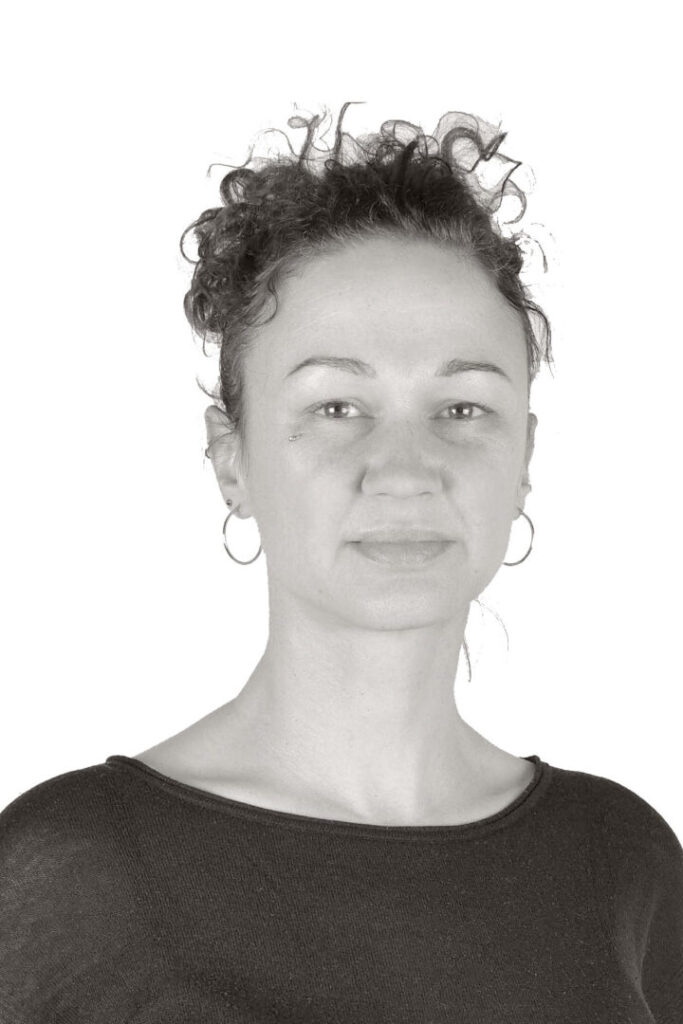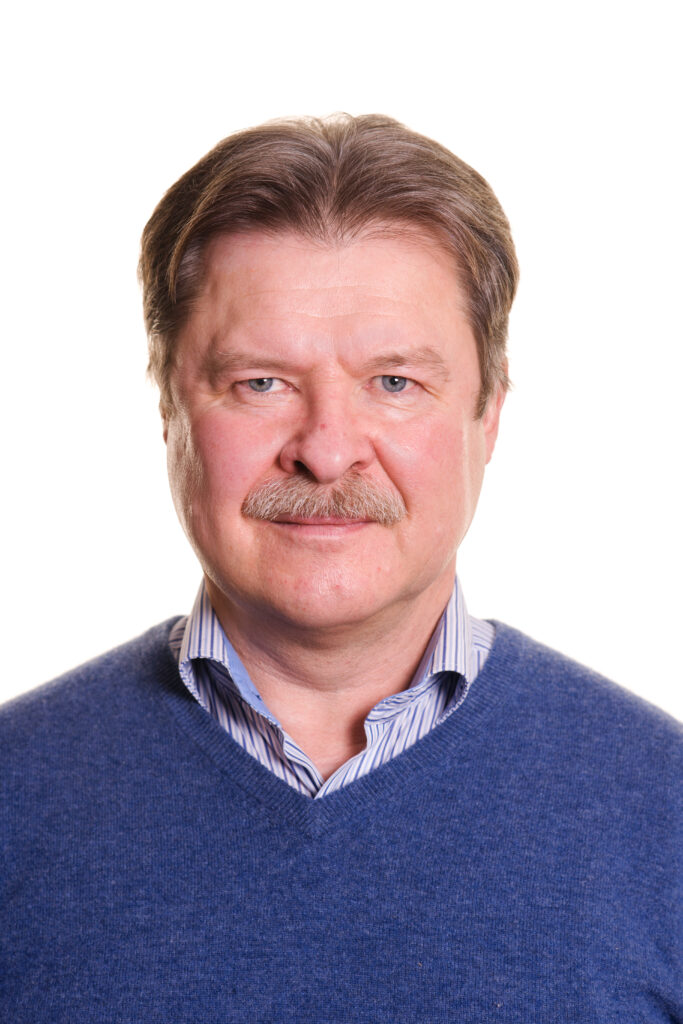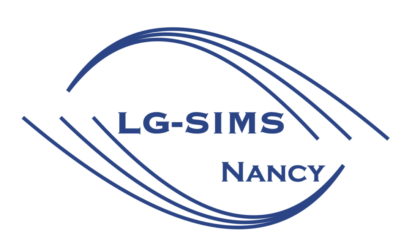
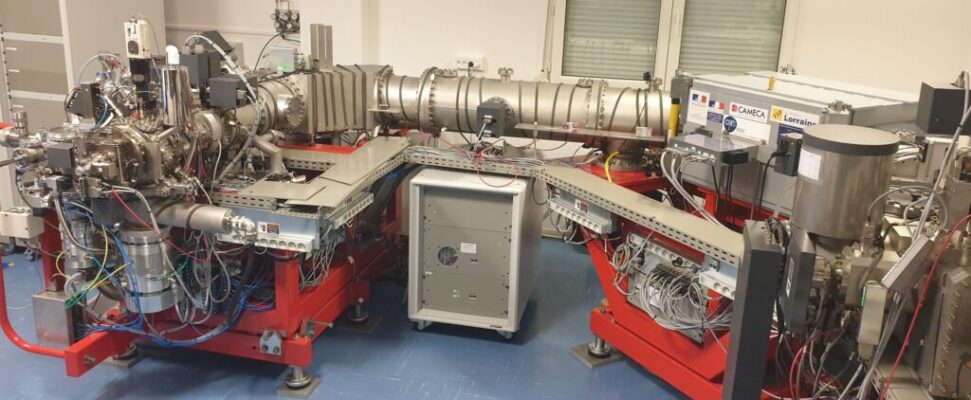
Scientific lead
Lab manager
Research support staff
Associated researchers
The LG-SIMS-Nancy analytical facility specializes in in situ isotopic and elemental analyses by secondary ion mass spectrometry (SIMS) at high spatial resolution (hundreds of nanometers to tens of micrometers), high sensitivity, and high precision.
SIMS is used to measure elemental concentrations and isotopic compositions in solids (glasses, minerals, alloys, metals, etc.) for ions with elements ranging from that of hydrogen to that of uranium.
The most common analyses on our instruments are stable isotopic analyses, both traditional (H, C, N, O, and S) and non-traditional (Li, Be, B, Mg, Si, Cl, Ca, Fe, Cu, Pb), isotopic dating (U–Pb, Al–Mg, Mn–Cr, Rb–Sr, and K–Ca), and analyses of trace element (rare earths, halogens) and volatile concentrations (CO2, H2O).
The LG-SIMS-Nancy analytical facility at the CRPG—designated an INSU National Instrument and integrated into the RéGEF SIMS research infrastructure—is the only laboratory in France equipped with these instruments and, since 1998, has welcomed French researchers upon request. This facility is also part of the European Europlanet research infrastructure, through which it welcomes researchers from other laboratories throughout Europe.
équipements
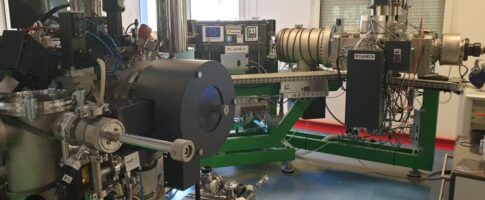
IMS 1270-E7 (LG-SIMS)
History:
First installed at the CRPG in 1996, this instrument’s electronic and vacuum systems were completely replaced in 2014. A new cryogenic system (a cold trap to achieve a better vacuum) and six-place sample airlock were added in 2021. The IMS 1270-E7 has been equipped with a Hyperion radio-frequency (RF) oxygen ion source. This instrument’s performance is currently equivalent to that of IMS 1280/IMS 1300.
Features:
The IMS 1270-E7 is equipped with a new optical imaging system adapted from the IMS 1300 LG-SIMS and facilitating the identification of micrometric phases and minerals.
The monocollection Faraday cage is equipped with a 1012 Ω preamplification card. This new card significantly reduce the electronic noise during analyses, improving analytical precision at low count rates (e.g., ±0.2‰ compared to ±0.6‰ with a 1011 Ω card at a count rate of 6 × 105 cps; Bouden et al., 2021).
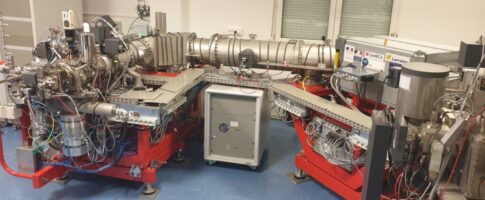
IMS 1280-HR2 (LG-SIMS)
History:
This instrument was first installed at the CRPG in 2009 and was equipped with a Hyperion RF oxygen ion source in 2017.
Features:
The form of the magnetic sector of the mass spectrometer in the IMS 1280-HR2 is optimized to achieve very high mass resolutions (MRP up to 45,000).
The monocollection and multicollection Faraday cages are equipped with 1012 Ω preamplification cards. These new cards significantly decrease the electronic noise during analyses, improving analytical precision at low count rates (e.g., ±0.2‰ compared to ±0.6‰ with a 1011 Ω card at a count rate of 6 × 105 cps; Bouden et al., 2021).
Acess/Prices
The LG-SIMS-Nancy facility is an INSU (SN-INSU/CNRS) national service that welcomes the projects of ‘internal’ users (CRPG researchers and their direct collaborators) as well as projects submitted by the French scientific community within the framework of INSU National Instruments and ‘external’ projects (i.e. within the Europlanet network, foreign universities, industry, private sector).
Requests for access to the platform should be made using the form to be downloaded, completed and sent to the generic address crpg-lgsims@univ-lorraine.fr.
For first-time requests or specific questions, please contact platform staff in advance (crpg-lgsims@univ-lorraine.fr). Facility members can provide guidance concerning the feasibility of the measurements, reference material availability, and the expected analytical time.
All users must accept the conditions of access and work within the facility by signing the facility use charter (version française or English version).
Prices:
Please contact the platform managers for a detailed estimate of the cost.
CNRS unit: 558 €/day (excl. tax)
Academic outside CNRS: 1395 €/day (excl. tax)
Private partner: 5308 €/day (excl. tax)
SAMPLE PREPARATION FOR AN ANALYTICAL SESSION
SIMS analyses require that the samples to be analyzed are perfectly flat and without asperities; a poor sample surface can reduce the quality of the analyses. Rock and mineral samples analyzed by SIMS are generally polished to 1 µm or 0.25 µm.
Different sample sizes and formats can be adapted to the sample holders of the LG-SIMS instruments, but we privilege thin sections (25 mm × 30 mm) or 1-inch (2.54 cm) circular sections ~1–5 mm thick.
If possible, we privilege samples mounted in indium, which promotes better vacuum conditions (via rapid degassing) and electrical conductivity. Non-conductive samples are gold- or carbon-covered before analyses.
For more atypical sample formats and unique cases, it is necessary to discuss sample preparation with the facility staff multiple weeks before analysis.
In general, it is highly recommended to contact the LG-SIMS-Nancy facility (crpg-lgsims@univ-lorraine.fr) in advance to discuss sample preparation. Together, we will determine the best preparation procedure so that the samples will meet the requirements and specifications of SIMS analyses.
We can provide technical support and provide access to sample preparation equipment and materials prior to analytical sessions. However, sample preparation remains the responsibility of the users (see the facility use charter).
members
RECENT PUBLICATIONS
2024
Asset, N., Chaussidon, M., Villeneuve, J., Charnoz, S., Koeberl, C., Wannier, M., & Robert, F. (2024). Condensation of fallout glasses in the Hiroshima nuclear fireball resulting in oxygen mass-independent fractionation. Earth and Planetary Science Letters, 626, 118473. https://doi.org/https://doi.org/10.1016/j.epsl.2023.118473
Barth, A., Portnyagin, M., Mironov, N., Holtz, F., Moussallam, Y., Rose-Koga, E. F., Rasmussen, D., Towbin, H., Gonnermann, H., Mutch, E. J. F., Rotolo, S. G., & Plank, T. (2024). Fast, furious, and gassy: Etna’s explosive eruption from the mantle. Earth and Planetary Science Letters, 643, 118864. https://doi.org/https://doi.org/10.1016/j.epsl.2024.118864
Dalou, C., Riguet, L., Villeneuve, J., Tissandier, L., Rigaudier, T., Cividini, D., Zollinger, J., & Paris, G. (2024). Synthesis and Characterization of Metallic (Fe-Ni, Fe-Ni-Si) Reference Materials for SIMS S/S Measurements. Geostandards and Geoanalytical Research, 48(4), 927–940. https://doi.org/https://doi.org/10.1111/ggr.12584
Deligny, C., Piralla, M., Villeneuve, J., Füri, E., & Marrocchi, Y. (2024). Potential Chronological Disturbance of the D’Orbigny Angrite Inferred from Discordant 26Al Ages. The Astrophysical Journal Letters, 975(1), L16. https://doi.org/10.3847/2041-8213/ad8654
Dürkefälden, A., Hauff, F., Hoernle, K., Portnyagin, M., Wartho, J.-A., Garbe-Schönberg, D., Gurenko, A., van den Bogaard, P., Kipf, A., & Gutjahr, M. (2024). Geochemical and temporal evolution of Indian MORB mantle revealed by the Investigator Ridge in the NE Indian Ocean. Gondwana Research, 134, 347–364. https://doi.org/https://doi.org/10.1016/j.gr.2024.07.016
Garcia Dobarganes-Bueno, J. E., Levresse, G., Estrada-Carmona, J., Nieto-Samaniego, A. F., Deloule, E., & Orozco-Esquivel, T. (2024). Chronological sequence of charcas igneous complex and their relationships with Zn–Pb–Ag mineralization events, San Luis Potosi state, Mexico. Journal of South American Earth Sciences, 138, 104814. https://doi.org/https://doi.org/10.1016/j.jsames.2024.104814
Genot, I., Angiboust, S., & Cartigny, P. (2024). Multiple sulfur isotopes evidence deep intra-slab transport of sulfate-rich fluids. Geochimica et Cosmochimica Acta, 377, 84–100. https://doi.org/https://doi.org/10.1016/j.gca.2024.05.025
Ghosh, S., Stünitz, H., Raimbourg, H., Précigout, J., Di Carlo, I., Heilbronner, R., & Piani, L. (2024). Importance of grain boundary processes for plasticity in the quartz-dominated crust: Implications for flow laws. Earth and Planetary Science Letters, 640, 118767. https://doi.org/https://doi.org/10.1016/j.epsl.2024.118767
Jansen, C. A., Burkhardt, C., Marrocchi, Y., Schneider, J. M., Wölfer, E., & Kleine, T. (2024). Condensate evolution in the solar nebula inferred from combined Cr, Ti, and O isotope analyses of amoeboid olivine aggregates. Earth and Planetary Science Letters, 627, 118567. https://doi.org/https://doi.org/10.1016/j.epsl.2024.118567
Jonker, G., van Maldeghem, F., van Ginneken, M., Krämer Ruggiu, L., & Goderis, S. (2024). Oxygen isotopic compositions of fresh rooftop micrometeorites from the Budel collection—Insights into the contemporary cosmic dust flux. Meteoritics \& Planetary Science, 59(6), 1236–1257. https://doi.org/https://doi.org/10.1111/maps.14145
Lee, H., Moussallam, Y., Rose Koga, E. F., Piani, L., Villeneuve, J., Bouden, N., Gurenko, A. A., Monteleone, B., & Gaetani, G. A. (2024). High–precision determination of carbon stable isotope in silicate glasses by secondary ion mass spectrometry: Evaluation of international reference materials. Chemical Geology, 670, 122428. https://doi.org/https://doi.org/10.1016/j.chemgeo.2024.122428
Lehn, I., & de Oliveira Vasconcelos, C. (2024). The role of organic matter in Brazilian Pre-Salt carbonates. The Depositional Record, 0, 1-15. https://doi.org/https://doi.org/10.1002/dep2.311
Mahlé, T., Marrocchi, Y., Neukampf, J., Villeneuve, J., & Jacquet, E. (2024). The last generation of nebular chondrules possibly sampled in the CH/CBb chondrite Isheyevo. Geochimica et Cosmochimica Acta, 385, 74–86. https://doi.org/https://doi.org/10.1016/j.gca.2024.08.027
Marrocchi, Y., Longeau, A., Goupil, R. L., Dijon, V., Pinto, G., Neukampf, J., Villeneuve, J., & Jacquet, E. (2024). Isotopic evolution of the inner solar system revealed by size-dependent oxygen isotopic variations in chondrules. Geochimica et Cosmochimica Acta, 371, 52–64. https://doi.org/https://doi.org/10.1016/j.gca.2024.03.001
Moussallam, Y., Towbin, W. H., Plank, T., Bureau, H., Khodja, H., Guan, Y., Ma, C., Baker, M. B., Stolper, E. M., Naab, F. U., Monteleone, B. D., Gaetani, G. A., Shimizu, K., Ushikubo, T., Lee, H. J., Ding, S., Shi, S., & Rose-Koga, E. F. (2024). ND70 Series Basaltic Glass Reference Materials for Volatile Element (HO, CO, S, Cl, F) Measurement and the C Ionisation Efficiency Suppression Effect of Water in Silicate Glasses in SIMS. Geostandards and Geoanalytical Research, 48(3), 637–660. https://doi.org/https://doi.org/10.1111/ggr.12572
Portnyagin, M., Dürkefälden, A., Hauff, F., Gurenko, A., Frick, D. A., Garbe-Schönberg, D., & Hoernle, K. (2024). A distinct type of MORB formed by two-stage melting of a hybrid mantle during Gondwana breakup. Earth and Planetary Science Letters, 647, 119021. https://doi.org/https://doi.org/10.1016/j.epsl.2024.119021
Rollion-Bard, C., Jurikova, H., & Henkel, D. (2024). High-resolution carbon and oxygen isotopic compositions of cultured brachiopods: Effect of pH, temperature and growth. Chemical Geology, 659, 122132. https://doi.org/https://doi.org/10.1016/j.chemgeo.2024.122132
Sun, Y., Jiao, Y., Cuney, M., Wu, L., Mercadier, J., Rong, H., Liu, Y., & Tao, Z. (2024). Sulfur isotope and trace element constraints on the conditions of pyrite formation from the Diantou-Shuanglong sandstone-hosted uranium deposit, Ordos Basin, China: Implications for uranium mineralization. Ore Geology Reviews, 165, 105921. https://doi.org/https://doi.org/10.1016/j.oregeorev.2024.105921
van Gerve, T. D., Neave, D. A., Wieser, P., Lamadrid, H., Hulsbosch, N., & Namur, O. (2024). The Origin and Differentiation of CO2-Rich Primary Melts in Ocean Island Volcanoes: Integrating 3D X-Ray Tomography with Chemical Microanalysis of Olivine-Hosted Melt Inclusions from Pico (Azores). Journal of Petrology, 65(2), egae006. https://doi.org/10.1093/petrology/egae006
van Gerve, T. D., Neave, D. A., Wieser, P., Lamadrid, H., Hulsbosch, N., Namur, O., Marrocchi, Y., Longeau, A., Goupil, R. L., Dijon, V., Pinto, G., Neukampf, J., Villeneuve, J., Jacquet, E., Dürkefälden, A., Hauff, F., Hoernle, K., Portnyagin, M., Wartho, J.-A., … Plank, T. (2024). Fast, furious, and gassy: Etna’s explosive eruption from the mantle. Gondwana Research, 65(2), 52–64. https://doi.org/https://doi.org/10.1016/j.epsl.2024.118864
van Ginneken, M., Harvey, R. P., Goderis, S., Artemieva, N., Boslough, M., Maeda, R., Gattacceca, J., Folco, L., Yamaguchi, A., Sonzogni, C., & Wozniakiewicz, P. (2024a). The identification of airbursts in the past: Insights from the BIT-58 layer. Earth and Planetary Science Letters, 627, 118562. https://doi.org/https://doi.org/10.1016/j.epsl.2023.118562
van Ginneken, M., Harvey, R. P., Goderis, S., Artemieva, N., Boslough, M., Maeda, R., Gattacceca, J., Folco, L., Yamaguchi, A., Sonzogni, C., & Wozniakiewicz, P. (2024b). The identification of airbursts in the past: Insights from the BIT-58 layer. Earth and Planetary Science Letters, 627, 118562. https://doi.org/https://doi.org/10.1016/j.epsl.2023.118562
Van Maldeghem, F., Maeda, R., Soens, B., Suttle, M. D., Ruggiu, L. K., Cordier, C., Yamaguchi, A., Schmitz, B., Claeys, P., Folco, L., & Goderis, S. (2024). Chrome-rich spinels in micrometeorites from modern Antarctic sedimentary deposits. Earth and Planetary Science Letters, 641, 118837. https://doi.org/https://doi.org/10.1016/j.epsl.2024.118837
2023
Bilau A., Bienveignant D., Rolland Y., Schwartz S., Godeau N., Guihou A., Deschamps P., Mangenot X., Brigaud B., Boschetti L., Dumont T. (2023). The Tertiary structuration of the Western Subalpine foreland deciphered by calcite-filled faults and veins. Earth Sci. Rev., 236, 104270. https://doi.org/10.1016/j.earscirev.2022.104270.
Charrieau L. M., Rollion-Bard C., Terbrueggen A., Wilson D. J., Pogge von Strandmann P. A. E., Misra S., Bijma J. (2023). Controls on Lithium Incorporation and Isotopic Fractionation in Large Benthic Foraminifera. Minerals, 13, 127. https://doi.org/10.3390/min13010127.
Corre M., Brunet F., Schwartz S., Gautheron C., Agranier A., Lesimple S. (2023). Quaternary low-temperature serpentinization and carbonation in the New Caledonia ophiolite. Scientific Reports, 13, #19413. https://doi.org/10.1038/s41598-023-46691-y.
Decrée S., Deloule E., Barros R., Mercadier J., Höhn S., Peiffert C., Baele J. P. M. (2023). Processes controlling Rare Earth Element distribution in sedimentary apatite: Insights from spectroscopy, in-situ geochemistry and O and Sr isotope composition.. Sedimentology. https://doi.org/10.1111/sed.13160.
Deligny C., Füri E., Deloule E., Peslier A. H., Faure F., Marrocchi Y. (2023). Origin of nitrogen on Mars: First in situ N isotope analyses of martian meteorites.. Geochim. Cosmochim. Acta., 344, 134-145. https://doi.org/10.1016/j.gca.2023.01.017.
Esposito R., Redi D., Danyushevsky L. V., Gurenko A., De Vivo B., Manning C. E., Bodnar R. J., Steele-Macinnis M., Frezzotti M.-L. (2023). Constraining the volatile evolution of mafic melts at Mt. Somma–Vesuvius, Italy, based on the composition of reheated melt inclusions and their olivine hosts. Europ. J. Mineral., 35, 921-948. https://doi.org/10.5194/ejm-35-921-2023.
Lotout C., Indares A., Vervoort J., Deloule E. (2023). High-P metamorphism in the Mesoproterozoic: Petrochronological insights from the Grenville Province. Precamb. Res., 399, 107208. https://doi.org/10.1016/j.precamres.2023.107208.
Marrocchi Y., Jacquet E., Neukampf J.,Villeneuve J., Zolensky M. (2023). For whom Bells tolls: Reclassifying Bells among CR chondrites and implications for the formation conditions of CR parent bodies. Meteor. Planet. Sci., 58, 195-206. https://doi.org/10.1111/maps.13947.
Marrocchi Y., Rigaudier T., Piralla M., Piani L. (2023). Hydrogen isotopic evidence for nebular pre-hydration and the limited role of parent-body processes in CM chondrites. Earth. Planet. Sci. Lett., 611, 118151. https://doi.org/10.1016/j.epsl.2023.118151.
Melfou M., Richard A., Tarantola A., Villeneuve J., Carr P., Peiffert C., Mercadier J., Dean B., Drejing-Carroll D. (2023). Tracking the origin of metasomatic and ore-forming fluids in IOCG deposits through apatite geochemistry (Nautanen North deposit, Norrbotten, Sweden). Lithos, 438-439, 106995. https://doi.org/10.1016/j.lithos.2022.106995.
Mourey A. J., France L., Ildefonse B., Gurenko A., Laporte D. (2023). Genesis of carbonatite at Oldoinyo Lengai (Tanzania) from olivine nephelinite: protracted melt evolution and reactive porous flow in deep crustal mushes. J. Petrol., egad084. https://doi.org/10.1093/petrology/egad084.
Moussalam Y., Georgeais G., Rose-Koga E. F., Koga K. T., Hartley M. E., Scaillet B., Oppenheimer C., peters N. (2023). CO2 undersaturated melt inclusions from the South West Indian ridge record surprisingly uniform redox conditions. Geochem. Geophys. Geosyst., 24, e2023GC011235. https://doi.org/10.1029/2023GC011235.
Neukampf J., Ellis B., Magna T, Laurent O., Marrocchi Y. (2023). Partitioning and isotopic fractionation of Li between mineral phases and alkaline to calc-alkaline melts of explosive and effusive eruptions. Chem. Geol., 636, 121628. https://doi.org/10.1016/j.chemgeo.2023.121628.
Ougadire M., Askkour F., Favier A., Ousbih M., Ikenne M., Geraud Y. (2023). Petrogenesis of the late Ediacaran A-type granites of the western part of the Moroccan Anti-Atlas belt: Insights from U–Pb dating, geochemistry and Sr–Nd isotopes of the Sidi El Houssein, Tafraout and Taourgha intrusions. J. Afr. Earth Sci., 203, 104947. https://doi.org/10.1016/j.jafrearsci.2023.104947.
Piani L., et al. (87 authors) (2023). Hydrogen Isotopic Composition of Hydrous Minerals in Asteroid Ryugu. The Astrophys. J. Lett., 946, L43. https://doi.org/10.3847/2041-8213/acc393.
Piralla M., Villeneuve J., Schnuriger N., Bekaert D. V., Marrocchi Y. (2023). A unified chronology of dust formation in the early solar system. Icarus, 394, 115427. https://doi.org/10.1016/j.icarus.115427.
Prabha-Mohan, S., Koga, K.T., Mathieu, A., Pointud, F., Narvaez, D.F., One-atmosphere high-temperature CO–CO2–SO2 gas-mixing furnace: design, operation, and applications. Europ. J.Mineral., 35, 321-331. https://doi:10.5194/ejm-35-321-2023.
Thomassin D., Piani L., Villeneuve J., Caumon M.-C., Bouden N., Marrocchi Y. (2023). The high-temperature origin of hydrogen in enstatite chondrite chondrules and implications for the origin of terrestrial water. Earth. Planet. Sci. Lett., 616, 118225. https://doi.org/10.1016/j.epsl.2023.118225.
Vésin C., Rubato D., Pettke T., Deloule E. (2023). Multistage hydration during oceanic serpentinisation revealed by in situ oxygen isotope and trace element analyses. Geochim.. Cosmochim. Acta., 355, 13-31. https://doi.org/10.1016/j.gca.2023.06.032.
Wagner C., Villeneuve J., Boudouma O., Rividi N., Orberger B., Nabatian G., Honarmand M., Monsef I. (2023). In Situ Trace Element and Fe-O Isotope Studies on Magnetite of the Iron-Oxide Ores from the Takab Region, North Western Iran: Implications for Ore Genesis. Minerals. 13, 774. https://doi.org/10.3390/min13060774.
2022
Abidi R., Slim-Shimi N., Marignac C., Somarin A.K., Renac C., Deloule E., Hatira N., Gasquet D. (2022). The microbial controls on the deposition of Pb-Zn minerals in carbonate-hosted Tunisian ore deposits, Resource Geology, 72
Azzam F., Blaise T., Patrier P., Abd Elmola A., Beaufort D., Portier E., Brigaud B., Barbarand J., Clerc S. (2022). Diagenesis and reservoir quality evolution of the Lower Cretaceous turbidite sandstones of the Agat Formation (Norwegian North Sea): Impact of clay grain coating and carbonate cement. Marine Petrol. Geol., 142, 105768. https://doi.org/10.1016/j.marpetgeo.2022.105768
Borisova A. Y., Nédélec A., Zagrtdenov N. R., Toplis M. J., Bohrson W. A., Safonov O. G., Bindeman I. N., Melnik O. E., Pokrovski G. S., Ceuleneer G., Jochum K. P., Stoll B., Weis U., Bychlkov A. Y., Gurenko A. A. (2022). Hadean zircon formed due to hydrated ultramafic protocrust melting. Geology. 50, 300-304. https://doi.org/10.1130/G49354.1.
Bouilhol P., Debret B., Inglis E. C., Warembourg M., Grocolas T., Rigaudier T., Villeneuve J., Burton K. W. (2022). Decoupling of inorganic and organic carbon during slab mantle devolatilisation. Nature Com., 13, 308. https://doi.org/10.1038/s41467-022-27970-0.
Dallai L., Bianchini G., Avanzinelli R., Deloule E., Natali C., Gaeta M., Cavallo A., Conticelli S. (2022). Quartz-bearing rhyolitic melts in the Earth’s mantle. Nature Comm., 13:7765. https://doi.org/10.1038/s41467-022-35382-3.
Dalou C., Deligny C., Füri E. (2022). Nitrogen isotope fractionation during magma ocean degassing: tracing the composition of early Earth’s atmosphere. Geochem. Persp. Lett., 20, 27-31. https://doi.org/10.7185/geochemlet.2204.
Feignon J. G., Cluzel N., Schiavi F., Moune S., Roche O., Clavero J., Schiano P., Auxerre M. (2022). High CO2 content in magmas of the explosive andesitic Enco eruption of Mocho-Choshuenco volcano (Chile). Bull. Volc,. 84, #40. https://doi.org/10.1007/s00445-022-01550-y.
Ferrando C., Tribuzio R., Lissenberg C. J., France L., McLeod C. J., Basch V., Villeneuve J., Deloule E., Sanfilippo A. (2022). Brown Amphibole as Tracer of Tectono-Magmatic Evolution of the Atlantis Bank Oceanic Core Complex (IODP Hole U1473A). J. Petrol,. 63, 1-27. https://doi.org/10.1093/petrology/egac089.
Kawaguchi M., Koga K. T., Rose-Koga E., Shimizu K., Ushikubo T., Yoshiasa A. (2022). Sulfur isotope and trace elemment systematics in arc magmas: seeing through the degassing via a melt inclusion study of Kyushu Island volcanoes, Japan. J. Petrol., 63, egac061. https://doi.org/10.1093/petrology/egac061.
Lampe S., Soens B., Chernonozhkin S. M., Gonz.lez de Vega C., van Ginneken M., Van Maldeghem F., Vanhaecke F., Glass B. P., Franchi I. A., Terryn H., Debaille V., Claeys Ph., Goderis S. (2022). Decoupling of chemical and isotope fractionation processes during atmospheric heating of micrometeorites. Geochim Cosmochim Acta, 324, 221-239. https://doi.org/10.1016/j.gca.2022.02.008.
Liu J., Tao C., Zhou J., Shimizu K., Li W., Liang J., Liao S., Kuritani T., Deloule E., Ushikudo T., Nakagawa M., Yang W., Zhang G., Liu Y., Zhu C., Sun H., Zhou J. (2022). Water enrichment in the mid-ocean ridge by recycling of mantle wedge residue. Earth. Planet. Sci. Lett, 584, 117455. https://doi.org/10.1016/j.epsl.2022.117455.
Lorenzon S., Novella D., Nimis P., Jacobsen S. D., Thomassot E., Pamato M. G., Prosperi L., Lorenzetti A., Alvaro M., Brenker F., Salvadego F., Nestola F. (2022). Ringwoodite and zirconia inclusions indicate downward travel of super-deep diamonds. Geology. https://doi.org/10.1130/G50111.1.
Mamadou M.M., Cathelineau M., Deloule E., Reisberg L., Cardon O., Brouand M. (2022) The Tim Mersoï Basin uranium deposits (Northern Niger): geochronology and genetic model. Ore Geol. Rev., 145, 104905. DOI: 10.1016/j.oregeorev.2022.104905.
Marrocchi Y., Piralla M., Regnault M., Batanova V., Villeneuve J., Jacquet E. (2022). Isotopic evidence for two chondrule generations in CR chondrites and their relationships to other carbonaceous chondrites. Earth. Planet. Sci. Lett, 593, 117683. https://doi.org/10.1016/j.epsl.2022.117683.
Morin G. L. F., Marrocchi Y., Villeneuve J., Jacquet E. (2022). 16O-rich anhydrous silicates in CI chondrites: Implications for the nature and dynamics of dust in the solar accretion disk. Geochim. Cosmochim. Acta, 332, 203-219. https://doi.org/10.1016/j.gca.2022.
Radu I. B., Moine B. N., Bolfan-Casanova N., Ionov D. A., Devidal J.-L., Deloule E., Korsakov A. V., Golovin A. V., Oleinikov O. B., Cottin J. Y. (2022). Zoisite in cratonic eclogite xenoliths – Implications for water in the upper mantle. Lithos. 418-419, 106681. https://doi.org/10.1016/j.lithos.2022.106681.
Regnault M., Marrocchi Y., Piralla M., Villeneuve J., Batanova V., Schnuriger N., Jacquet E. (2022). Oxygen isotope systematics of chondrules in Rumuruti chondrites: Formation conditions and genetic link with ordinary chondrites. Meteor. Planet. Sci., 57, 122-135. https://doi.org/10.1111/maps.13778.
Rudraswami N.G., Suttle M.D., Marrocchi Y., Taylor S., Villeneuve J. (2022) In-situ O-isotope analysis of relict spinel and forsterite in small (<200µm) Antarctic micrometeorites – samples of chondrules & CAIs, primarily from carbonaceous chondrites. Geochim. Cosmochim. Acta, 325, 1-24, https://doi.org/10.1016/j.gca.2022.03.015.
Schnuriger N., Cartier C., Villeneuve J., Batanova V., Regnault M., Marrocchi Y. (2022). Oxygen isotope systematics of chondrules in Rumuruti chondrites: Formation conditions and genetic link with ordinary chondrites. Meteor. Planet. Sci., 57, 1018-1037. https://doi.org/10.1111/maps.13802.
Soens B., Chernonozhkin S. M., González de Vega C., Vanhaecke F., van Ginneken M., Claeys Ph., and Goderis S. (2022). Characterization of achondritic cosmic spherules from the Wider.efjellet micrometeorite collection (S.r Rondane Mountains, East Antarctica). Geochim. Cosmochim. Acta, 325, 106-128. https://doi.org/10.1016/j.gca.2022.03.029.
Thiry M., Franke C., Yao K. F. E., Szuszkiewicz A., Fàbrega C., Jeleńska M., Kądziałko-Hofmokl M., Gurenko A., Parcerisa D., Sobczyk A., Turniak K., Aleksandrowski P. (2022) Albitization and oxidation of Variscan granitoid rocks related to the post-Variscan paleosurface in the Sudetes (Bohemian Massif, SW Poland). Intern. J. Earth Sci. DOI: 10.1007/s00531-022-02274-2.
Vézinet A., Thomassot E., Luo Y., Pearson D. G., Stern R. A., Sarkar C. (2022). Zircon geochronology and Hf–O isotopes of the Nulliak supracrustal assemblage (Saglek Block–Canada): Constraints on deposition age and setting, metamorphic age and environments of zircon crystallization. Precamb. Res., 379, 106789. https:// doi.org/10.1016/j.precamres.2022.106789.
Witt C., Poujol M., Chiaradia M., Villagomez D., Seyler M., Averbuch O., Bouden N. (2022). Geodynamic controls in the southernmost Northern Andes magmatic arc: Trace elements and Hf-O isotopic systematics in forearc detrital zircon . GSA Bull., https://doi.10.1130/B36510.1.
Xu Q.H., Wang L., Liu J., Deloule E., Hanski E., Gu X. Y., Chen H., Xia Q. K. (2022). Linking the Jehol Biota evolution to the Early Cretaceous volcanism during the North China craton destruction: Insights from F, Cl, S, and P. J. Geophys. Res.: Solid Earth, 127, e2022JB024388. https://doi.org/10.1029/2022JB024388.
Zelenski M., Kamenetsky V. S., Nekrylov N., Kontonikas-Charos A. (2022). High Sulfur in Primitive Arc Magmas, Its Origin and Implications. Minerals, 12, 37. https://doi.org/10.3390/min12010037.
2021
A., Wygralak A. S., Skirrow R. G., Mernagh T. P., Ion Probe Team Nancy. (2021). Uranium mobility and deposition over 1.3 Ga in the Westmoreland area ‘McArthur Basin, Australia). Min. Depos., https://doi.org/10.1007/s00126-020-01031-2
Gress M. U., Timmerman S., Chinn I. L., Koornneef J. M., Thomassot E., van der Valk E. A. S., van Zuilen K., Bouden N., Davies G. R. (2021). Two billion years of episodic and simultaneous websteritic and eclogitic diamond formation beneath the Orapa kimberlite cluster, Botswana. Contrib. Mineral. Petrol. 176:54. https://doi. org/10.1007/s00410-021-01802-8
Richter F., Saper L. M., Villeneuve J., Chaussidon M., Watson E. B., Davis A. M., Mendybaev R. A., Simon S. B. (2021). Reassessing the thermal history of martian meteorite Shergotty and Apollo mare basalt 15555 using kinetic isotope fractionation of zoned minerals. Geochim. Cosmochim. Acta, 295, 265-285. https:// doi.org/10.1016/j.gca.2020.11.002
Rutman P., Hoareau G., Kluska J.- M., Lejay A., Fialips C., Gelin F., Aubourg C., Hernandez-Bilbao E. (2021). Diagenesis and alteration of subsurface volcanic ash beds of the Vaca Muerta Formation, Argentina. Marine Petrol. Geol., 132. #105220.
Van Ginneken M., Goderis S., Artemieva N., Debaille V., Decrée S., Harvey P., Huwig K. A., Hecht L., Yang S., Kaufmann F. E. D., Soens B., Humayun M., Van Maldeghem F., Genge M. J., Claeys P. (2021). A large meteoritic event over Antarctica ca. 430 ka ago inferred from chondritic spherules from the Sør Rondane Mountains. Science Adv., 7/14. https://doi.org/10.1126/sciadv.abc1008











